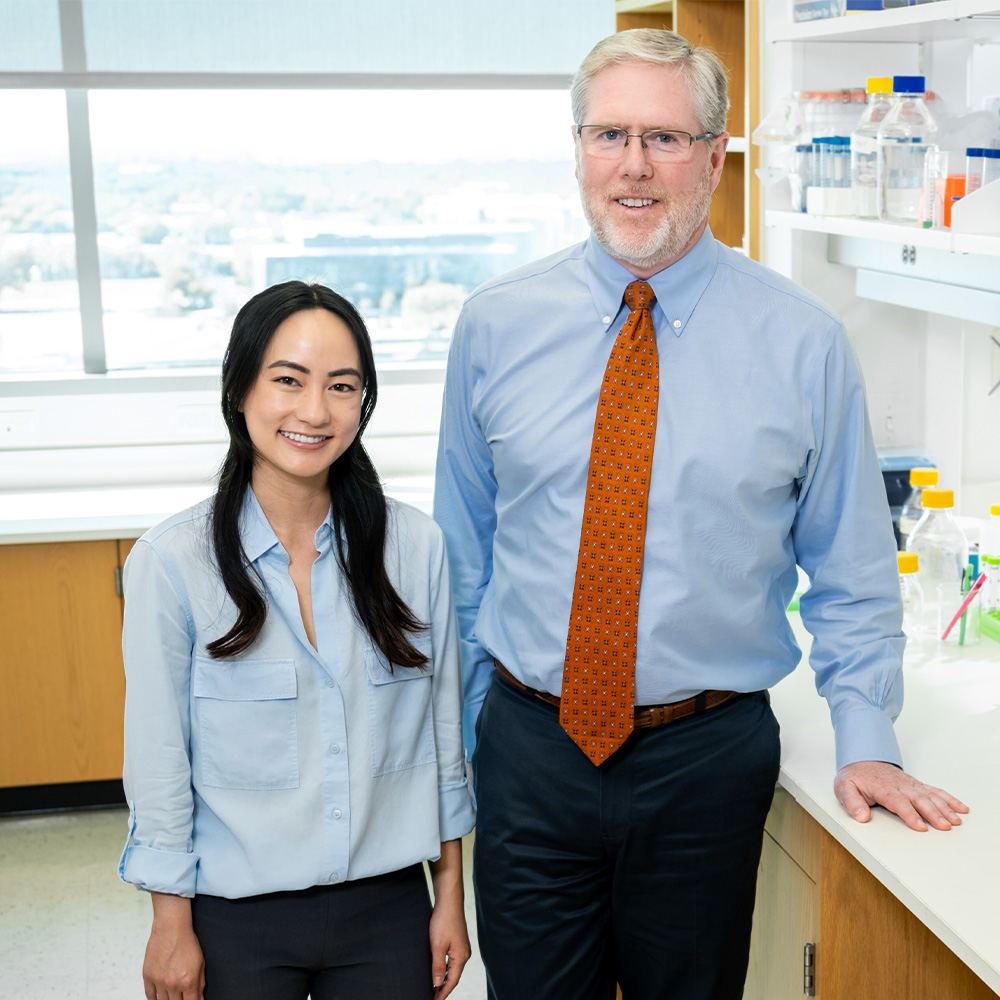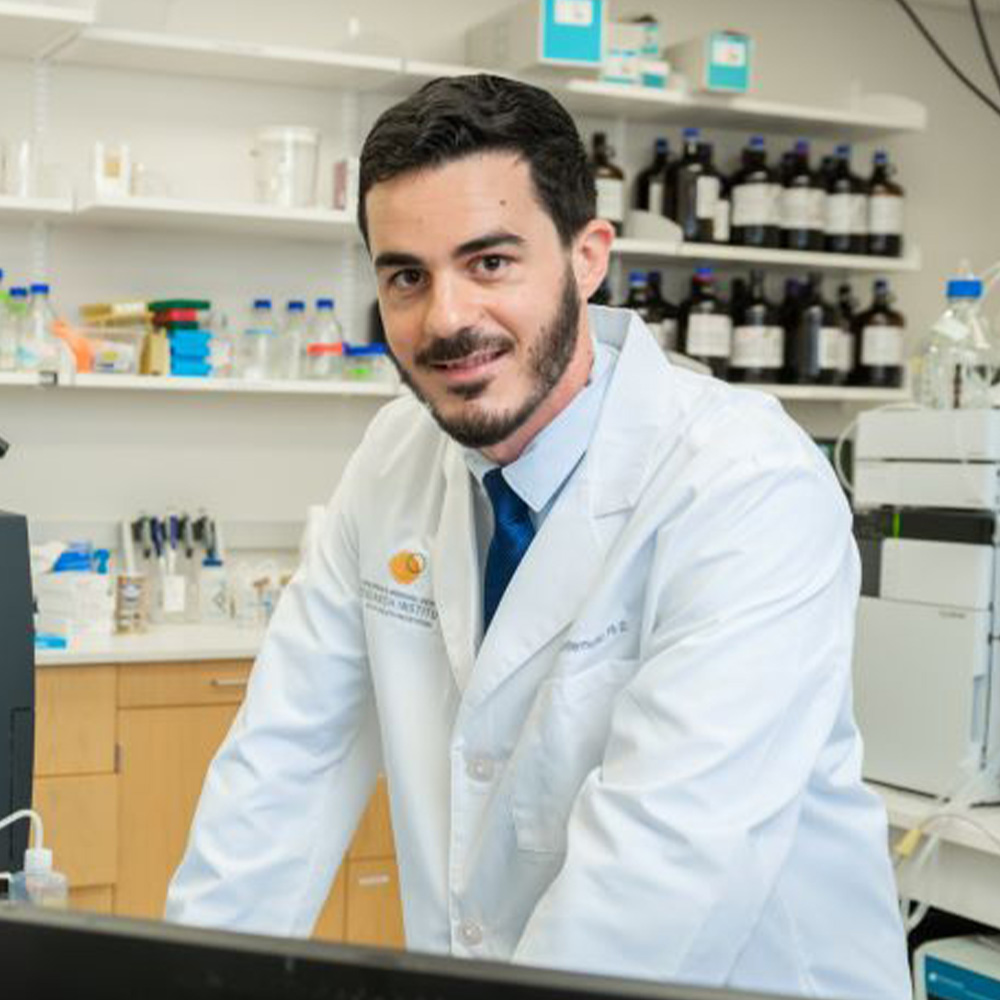Study: New approach to destroying deadly brain tumors
Update: Video added September 11, 2017
DALLAS – June 12, 2017 – A new strategy for treating brain tumors may extend or save the lives of patients diagnosed with one of the deadliest forms of cancer, according to a study from UT Southwestern Medical Center.
The research demonstrates in mice that a combination of medications – traditionally used separately to treat lung cancer and arthritis – can destroy glioblastoma, a difficult-to-treat brain tumor that is lethal to most patients in little more than a year.
The combination of these medications disables two proteins responsible for helping the cancer cells survive, providing a therapy that UT Southwestern is working to fast-track for clinical use.
“This could be a groundbreaking treatment. If it works in patients, then it will be an important advance,” said Dr. Amyn Habib, a member of UT Southwestern’s Peter O’Donnell Jr. Brain Institute and the Harold C. Simmons Comprehensive Cancer Center.
The research published in Nature Neuroscience answers a decades-old question of why a treatment that disables a protein common in various cancers has been effective in some forms of lung and colon cancer but not in glioblastoma.
The protein, known as epidermal growth factor receptor (EGFR), resides in the tumor cell’s membrane and has been a traditional target for fighting malignant tumors. Dr. Habib’s team found that when doctors use a medication to disable the receptor, a second protein is produced in the brain that takes over the receptor’s function to keep the cancer cell alive.

The study shows that blocking both the receptor and the tumor necrosis factor (TNF) destroys the glioma tumors.
The medications used to disable these proteins are already approved by the U.S. Food and Drug Administration, including TNF inhibitors used to treat arthritis and other rheumatologic conditions. Dr. Habib said this could speed the effort at UT Southwestern to organize a clinical trial to test the treatment on lung cancer and glioblastoma patients.
“This is a terrific example of research that can be relatively quickly carried into the clinic,” said Dr. Habib, Associate Professor of Neurology & Neurotherapeutics.

Glioblastoma is the most lethal and common type of brain cancer, accounting for 17 percent of malignant brain tumors. The disease aggressively spreads through the brain and can prove fatal within months, though surgery, chemotherapy, and radiation treatments can often help patients survive more than a year.
UT Southwestern is testing an array of other approaches to improve the prognosis for patients, from protein-inhibiting medications to immunotherapy that uses the body’s immune system to fight the cancer.
Dennis Kothmann, a retired math teacher with glioblastoma, hopes one of these approaches will work for him. While Dr. Habib’s treatment strategy is still being prepared for clinical use, Mr. Kothmann is participating in an immunotherapy clinical trial at UT Southwestern.
“Chemo hasn’t worked very well for other people with this disease,” he explained as a nurse prepared to deliver his latest infusion through his arm. “Why not try something different, give yourself a chance?”

The 71-year-old Fort Worth native was diagnosed with glioblastoma in November after seeking medical treatment for his headaches and vision problems. Mr. Kothmann tells his story with an inspiring air of positivity, his jovial smile belying the grim prospects for beating such a disease.
“There’s no sense in getting down,” Mr. Kothmann said, his wife Candace nodding in agreement next to him. “That’s not going to make me better.”
Dr. Habib is encouraged by the initial success of his protein-disabling strategy. But he acknowledges a cure may not be imminent because cancers tend to adapt to treatments and find other pathways to thrive if one is blocked.
For example, disabling the EGFR protein initially showed success in lung cancer patients, but over time the cells develop resistance to the medication.
“But if we can provide a remission or slowing of the disease and extend survival, that’s a big advance in fighting this devastating disease,” said Dr. Habib, also a staff physician at the North Texas VA Medical Center.
The study was supported by the National Institutes of Health, the Office of Medical Research, and Department of Veterans Affairs. Other pcollaborators at UT Southwestern include Dr. Gao Guo, a postdoctoral researcher in Dr. Habib’s laboratory, and Dr. Edward Pan, Associate Professor of Neurology & Neurotherapeutics, Neurological Surgery, Dr. Sandeep Burma, Associate Professor of Radiation Oncology, Dr. Kimmo Hatanpaa, Associate Professor of Pathology, Dr. Bruce Mickey, Vice Chairman and Professor of Neurosurgery, and Dr. David Wang, Associate Professor of Internal Medicine.
The Harold C. Simmons Comprehensive Cancer Center is the only NCI-designated Comprehensive Cancer Center in North Texas and one of just 47 NCI-designated Comprehensive Cancer Centers in the nation. Simmons Cancer Center includes 13 major cancer care programs. In addition, the Center’s education and training programs support and develop the next generation of cancer researchers and clinicians. Simmons Cancer Center is among only 30 U.S. cancer research centers to be designated by the NCI as a National Clinical Trials Network Lead Academic Participating Site.
About UT Southwestern Medical Center
UT Southwestern, one of the premier academic medical centers in the nation, integrates pioneering biomedical research with exceptional clinical care and education. The institution’s faculty has received six Nobel Prizes, and includes 22 members of the National Academy of Sciences, 18 members of the National Academy of Medicine, and 14 Howard Hughes Medical Institute Investigators. The faculty of more than 2,700 is responsible for groundbreaking medical advances and is committed to translating science-driven research quickly to new clinical treatments. UT Southwestern physicians provide care in about 80 specialties to more than 100,000 hospitalized patients, 600,000 emergency room cases, and oversee approximately 2.2 million outpatient visits a year.
###
Media Contact: James Beltran
214-648-3404
James.Beltran@utsouthwestern.edu
To automatically receive news releases from UT Southwestern via email, subscribe at www.utsouthwestern.edu/receivenews





